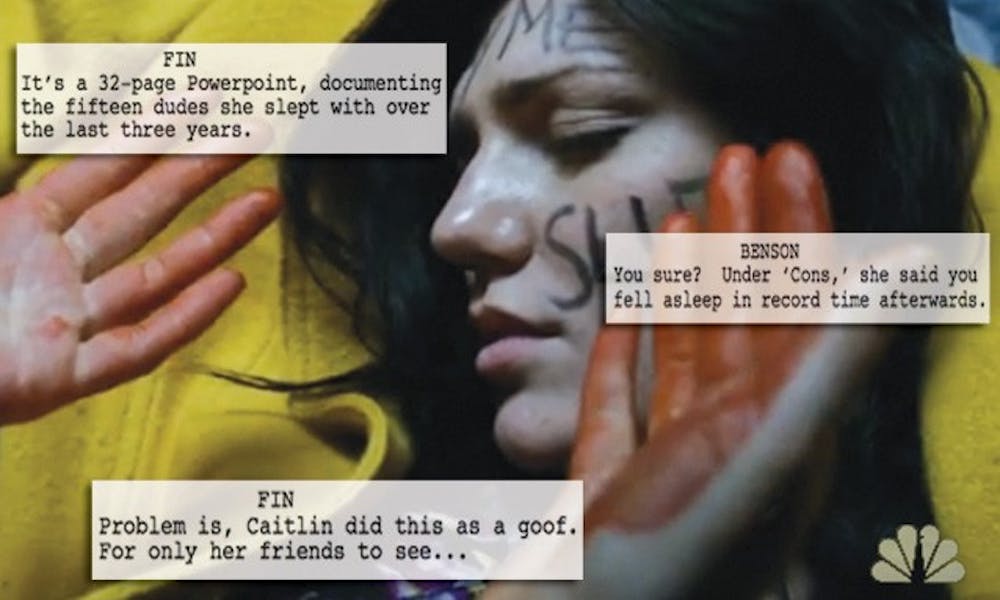After a raunchy PowerPoint detailing the sexual encounters of a Duke alumna went viral, some sympathetic Dukies found themselves asking a rhetorical question: Could it get any worse?
Only in the world of Law & Order: Special Victims Unit, apparently.
The PowerPoint, originally created by Karen Owen, Trinity ’10, was posted all over the web within days after she e-mailed it to her close friends. Now, two months after the presentation surfaced, Hollywood has picked up the story.
In an episode of the show that aired Wednesday night, a young ad mogul named Caitlin winds up dead after a PowerPoint she created ranking the penis sizes of her office conquests—titled “My Lay List: A Scholarly Treatise On Office Relationships”—goes viral.
As the investigation into the victim’s death proceeds, detective Olivia Benson rehashes the debate that raged on the blogosphere: “Cutting edge technology but the same ol’ double standard. Guys who sleep around are studs, girls are sluts.”
The episode mirrored the details of the real-life scandal so well—just two more men were ranked in a document that was 10 pages shorter than Owen’s presentation—that one blog satirically quipped: “Is Karen Owen in danger?”
In an interview with The Chronicle, Owen said she did not watch the episode and is not offended that her character was killed off—she sees it as a distinct work of fiction. Owen agreed to an interview with The Chronicle but declined to be quoted directly in this article.
SVU Producer Dan Truly, who wrote the episode, said Caitlin’s death should not be read as a reflection of his feelings about Owen’s actions.
“It’s really kind of a selfish thing from a writer’s point of view—it’s easier if the victim dies,” he said. “She could have told us what happened. I needed time to push off those revelations.”
The original Law & Order was famous for ripping stories from the headlines, but Truly said that the technique is less effective in the age of the Internet. Scandals have been thoroughly dissected in the blogosphere by the time an episode airs. But Owen’s story was the perfect fodder for a script, he said.
“We rip from Section B, Page 24—smaller stories that we can get a couple themes out of,” he said.
Michael Malone, a visiting professor of the practice of theater studies, noted that drawing from reality as inspiration for fiction is nothing new—even Shakespeare did it. But he fears the use of the technique has gotten out of hand in recent years.
“I have never known a fiction that didn’t have facts in it. But the fundamental point about telling stories is those facts are no excuse for fiction,” he said. “Just because it’s a real story doesn’t make it a good story. I worry we sometimes lose that distinction.”
To hold viewers’ interest, Truly explained that he always ensures that the twists of his script deviate considerably from what happen in real life. In any case, he noted, he had to set the Owen-inspired episode in an office because the show had recently aired an episode set on a college campus.
Mike Schoenfeld, vice president for public affairs and government relations, said he is grateful for the change.
“It made it even more oblique for the viewers. I don’t know how many people who watched that might have ultimately made the connection to Duke,” he said. “Something like this is not what you would necessarily seek out for coverage or attention.”
Schoenfeld noted that he is working to increase Hollywood’s evocations of Duke, so long as the point of reference is not a sex scandal.
“There are a lot of top colleges that have visibility. Look at ‘Legally Blonde,’” he said. “I would love for Duke to have more than its fair share of references in television and film.”
Law & Order: Special Victims Unit has given Duke a recurring role, though perhaps not one Schoenfeld would have chosen. The show also used the 2006 lacrosse case as the basis for an episode, Truly said.
“We should name a character ‘Duke’ because of all the stories you’ve given us,” he joked.
Ultimately, however, Owen’s PowerPoint says little about Duke as an institution, Truly noted. Sex and alcohol are staples of college life. Truly said he was drawn to Owen by the richness of her voice as a writer.
“I thought what she did was funny and clever,” he said. “I was so happy that I didn’t do what this girl did because I’m a writer, so I would have been dumb enough to make a list and try to be witty. I’m just glad that I didn’t have the Internet when I was growing up.”
Nevertheless, Truly could only milk Owen’s PowerPoint for four or five scenes—anything more would have felt like a stretch, he said. Caitlin’s murder was resolved well before the episode’s half-way mark, and the detectives moved on without ever mentioning the victim again.
Although she wishes Law & Order had not referenced her in the first place, Owen said she was relieved by the plot’s quick pivot. In the end, the story really was not about her at all.
Get The Chronicle straight to your inbox
Signup for our weekly newsletter. Cancel at any time.

